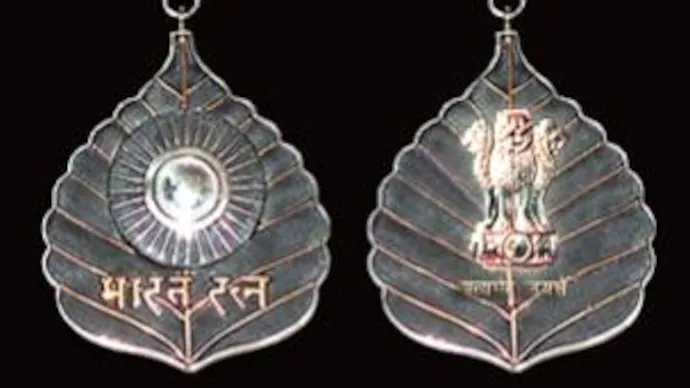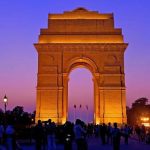Civilian awards are bestowed upon Indian citizens who have done exemplary work in any specific field. The Government of India selects an individual who has distinguished himself/herself in a field of work for a civilian award. People from various fields such as journalism, education, medicine, engineering, literature, sports, arts, social work, science, trade, and industry, etc. have received various civilian awards since independence.
The civilian awards are conferred by the President of India on Republic Day. The awards were first given in the year 1954. There are four types of civilian awards in the country. They are Bharat Ratna, Padma Vibhushan, Padma Bhushan and Padma Shri. Initially, Padma Vibhushan was classified into Pehla Warg, Dusra Warg, and Tisra Warg. In January 1955, Padma Bhushan and Padma Shri came into being. The awards are manufactured at the Government Mint in Kolkata.
List of Highest Civilian Awards in India
1. Bharat Ratna

Bharat Ratna is the highest civilian award in India. Bharat Ratna means the gem or jewel of India. Bharat Ratna is conferred for exceptional achievement in the field of Science, Literature, Arts or Public Service. In the year 2013, an amendment was done to include achievements in sports as a category. This was done to enable Sachin Tendulkar to be conferred with Bharat Ratna.
The first recipients of the award were Dr. CV Raman, C. Rajagopalachari, and Dr. S Radhakrishnan in the year 1954. Two foreign nationals have also been conferred Bharat Ratna since its inception. They are Nelson Mandela and Khan Abdul Gaffar Khan. Satyajeet Ray is the only filmmaker till date to have received Bharat Ratna. Lal Bahadur is the only Prime Minister who received Bharat Ratna posthumously. Jawaharlal Nehru, Indira Gandhi, and Atal Bihar Vajpayee are other Prime Ministers who have received Bharat Ratna. Other famous personalities who have received Bharat Ratna are MS Subbulakshmi, Lata Mangeshkar, Bismillah Khan, Bhimsen Joshi, Amartya Sen and Mother Teresa.
In 1992, the government of India decided to confer Bharat Ratna posthumously on Subhash Chandra Bose. However, the opposition by people who refused to accept the theory of his death in an air crash forced the government to cancel the award. This was the first and only time when the award was announced but not conferred. Sardar Vallabhai Patel, BR Ambedkar, and Pandit Madan Mohan Malviya have received Bharat Ratna posthumously.
Bharat Ratna medallion is in the form of a peepal leaf. It is about 5.8 cm in length, 4.7 cm in breadth and 3.1 in thickness. The main body is made of toned bronze. A replica of the sun is embossed on the front face of the award with the words ‘Bharat Ratna’ in Devnagiri embossed below the replica. On the reverse, the state emblem Ashok Stambha and ‘Saytamev Jayate’ are embossed. The state emblem, a replica of the sun and the rim are crafted of platinum. The letterings are in burnished bronze.
Bharat Ratna has no monetary benefit associated with it. It is not mandatory to award Bharat Ratna every year. Till date, 45 personalities have received the Bharat Ratna
2. Padma Vibhushan
Padma Vibhushan is the second highest civilian award of India. This award is given in recognition of exceptional achievements in the field of arts, science, and public services. Padma Bhushan medallion is circular. The diameter of the circle is 4.4cm, and the thickness is 0.6mm. Lotus flower crafted in white gold is embossed on the circular space of the award. The words ‘Padma Vibhushan’ is embossed in Devanagari script. The word ‘Padma’ is on the top of the lotus and the word ‘Vibhushan’ is below the lotus. On the reverse side of the award, the national emblem is embossed below which ‘Satyamev Jayate’ is inscribed. The border, inscriptions and the geometric patterns are made of burnished bronze while the embossing is done in white gold.
Padma Vibhushan was introduced in the year 1954. The first recipients of the award were Nand Lal Bose, SN Bose, JD Wangchuk, Zakir Hussain VK Menon and BG Kher. Padma Vibushan has been conferred on more than 300 personalities till date. This number includes 12 posthumous and 19 non-Indians. Sachin Tendulkar is the youngest recipient of Padma Vibhushan. He received the award in the year 2008. The names of the Padma Awardees for a particular year are announced on the Republic Day. A total of 68 personalities from the field of public service have received the award till date which is the highest for any field. From the year 2000 to 2009, the number of Padma Vibhushan awardees was maximum at 86.
Padma Vibhushan was first suspended in the year 1977 by the Morarji Desai government but was later restored in the year 1980 after Indira Gandhi returned to power. The award has no cash allowance or other monetary benefit associated with it.
3. Padma Bhushan
Padma Bhushan is the third highest civilian award conferred by the Government of India. Padma Bhushan is awarded to individuals excelling in any field or discipline including services by government employees. The design of the award is similar to that of Padma Vibhushan. The embossing, however, is done in standard gold instead of white gold. The inscription ‘Padma Bhushan’ in Devnagri, the geometric patterns and the border are in burnished bronze. Padma Bhushan was first awarded in the year 1954. The first recipients of the award were Homi Bhabha, MS Subbulakshmi, RR Handa, Sukumar Sen, Shanti Swaroop Bhatnagar, Amar Nath Jha and Radha Krishan Gupta.
A total of 1240 personalities have received the Padma Bhushan award from 1954 till 2018. The number of recipients was highest from 2000 to 2009 at 291. Padma Bhushan has been refused in the past by the selected personalities such as historian Romila Thapar, journalist Nikhil Chakravarty and sitar player Vilayat Khan. Novelist Khushwant Singh accepted the award in 1974 but returned it in 1984 in protest against Operation Blue Star launched to flush out terrorists from Golden Temple.
4. Padma Shri
Padma Shri is the fourth highest civilian award in India. Padma Shri is awarded for distinguished service in the field of education, science, literature, social service, public affairs, sports, medicine, and arts. The word ‘Padma’ is inscribed above the embossed lotus on the obverse while the word ‘Shri’ is inscribed below the lotus embossing. The lotus and the Ashok Stambha embossing are done in stainless steel while the geometric patterns on either side, inscriptions, and the border are done in burnished bronze.
Padma Shri award was introduced in the year 1954. The first recipients of the award were Dr. KR Chakraborty, Dr. Mathura Das, and Akhil Chandra Mitra. A total of 2840 individuals have been conferred Padma Shri from 1954 to 2018. Some individuals such as Bollywood screenwriter Salim Khan, author Mamoni Goswami, and sitar player Vilayat Khan have refused to accept Padma Shri award. There have been others such as author Phanishwar Nath Renu and poet Jayanta Mahapatra who have returned their Padma Shri after accepting it.
How is the selection made?
The Prime Minister of India makes the recommendation for awarding Bharat Ratna to an individual to the President of India. A maximum of three individuals can be awarded the Bharat Ratna in a year. An amendment was made to the statutes of Bharat Ratna which allowed Bharat Ratna to be awarded posthumously.
The Padma Awards Committee makes recommendations to the Prime Minister and President of India for awarding all the four Padma awards. This committee is constituted by the Prime Minister each year. The committee receives recommendations from the Ministers of the Government of India, state and union territory governments, members of parliament, governors and chief ministers of states, institutes of excellence and Bharat Ratna and Padma awardees.
In the year 2017, the BJP led NDA government brought about a radical change in the selection process for the Padma awards. The government invited the common people of India to make recommendations of names for the awards through an online portal run by the central government. The involvement of ministers and other famous people in making the recommendations was abolished. This was done to bring in more transparency to the selection process and involve the common citizen of the country in the process. As a result, many hitherto unknown individuals received the Padma awards in 2017 and 2018. The Prime Minister himself hinted in a speech at the possibility of politically connected people getting the Padma awards until then.
Cancellation of award
The President of India can cancel the award given to an individual in case of any kind of misconduct on the part of the recipient. The President has canceled Padma Shri awards on three occasions. Twice the Padma Shri was canceled for two recipients from Punjab in 1958 and once in 1974 for a recipient from Gujarat.
Controversies
There have been many controversies regarding the awards in the past. The most recent being the 2013 Bharat Ratna awarded to Sachin Tendulkar and scientist CNR Rao. A PIL was filed which alleged that Rao had proven cases of plagiarizing research papers against him and Tendulkar being a nominated member of Congress in Rajya Sabha was not eligible for the award.
The Bharat Ratna and the Padma awards are conferred without discrimination on the basis of gender, race, religion or region. Despite controversies, the highest civilian awards remain prestigious among the citizens of India.
Santosh Kumar, He is a SEO + Blogger have 12 years of experience in writing tutorial, informative and product reviews topics.
Page Contents

